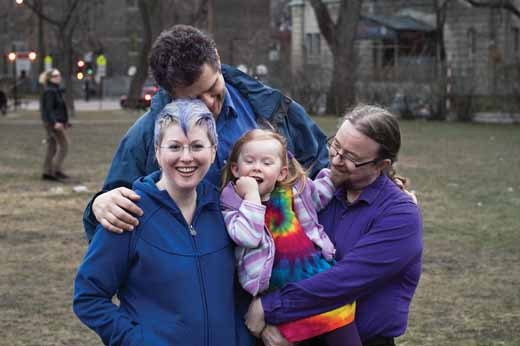For the past five years, computer techie John Robert Bashinski has shared his Montreal row house with two partners — one female, one male — and the trio’s kindergarten-aged daughter. It’s a polyamorous relationship — on the surface, hard to distinguish from polygamy, but in many ways, the polar opposite.
Egalitarian, secular and non-institutional, the family’s relationship is founded on the personal freedom of each of the three partners, he says. All three adults see other lovers outside their primary unit. Weekly, the partners also rotate on date nights, a two-adult romantic evening, while the third does childcare. It’s just your average three-parent “open” relationship, in other words. Bashinski reports they’re very public about it yet never harassed in their progressive, family-oriented neighbourhood.
You may unsubscribe from any of our newsletters at any time.
The household’s vibrancy is a relief for Bashinski. For 20 years between 1980 and 2000, he endured a marriage that ran out of steam soon after it began. Work brought him from the United States to Montreal. That’s when he met his current partners, and the new arrangement got his groove back. More sex, more love, more life.
“Polyamory seems to be on the upswing in the zeitgeist,” says Bashinski, who is a spokesperson for the Canadian Polyamory Advocacy Association (CPAA). “There may not be way more people publicly doing it, but it is becoming more visible, and more people are thinking of it as a valid option.”
The CPAA argues that polyamory, which literally means “many loves,” is far more widespread in Canada than its fundamentalist cousin, polygamy (Newsweek recently reported that there are 500,000 polyamorous families in the U.S.). The group refers to itself politically as the “poly majority.” Social acceptance, Bashinski reports, is on the rise. He credits the popularization of open marriages and the free love movement starting in the 1960s.
Legally, however, there’s a ways to go. In November, the B.C. Supreme Court upheld the 122-year-old law prohibiting polygamous marriages. The CPAA was an intervener in the case; Bashinski was one of five polyamorous Canadians who testified in favour of allowing egalitarian multi-partner relationships.
Still, the decision of B.C. Chief Justice Robert Bauman effectively decriminalized polyamory while confirming Canada’s anti-polygamy laws. While some polyamorous relationships are criminalized under section 293 of the Criminal Code (those that have been formalized through a ceremony or “sanctioning event”), most are not, Bauman clarified. But state-recognized polyamorous relationships may be coming.
In response to the judgment, the CPAA stated, “Decriminalization of homosexual relationships did not lead to the recognition of gay marriage until 30 years later. No doubt it will take some time for Canadians to determine whether they ever want to recognize multi-partner marriages.”
And indeed, there’s no consensus within the polyamorous community if legal marriage is a worthy fight. For Bashinski, an important part of being polyamorous is refusing to narrowly define relationships or sanctify them through a religion or the state. He doesn’t want a marriage — though he does value commitment. “If an arrangement is working, it’s foreign to me why I’d care whether my partner has other sexual partners. At the same time, we’ve all agreed that we’re not going to do anything that will destabilize our family.”
Bashinski does, however, worry about what would happen if his partners passed away; as they’re his daughter’s biological parents, he has no legal custodianship of her. Also, due to his tech skills, Bashinski had no trouble immigrating to Canada. He didn’t need a marriage. That’s not necessarily true for other internationals in poly relationships with Canadians, whose partnerships are not recognized by the government.
“Overall, we want normalization; we want acceptance,” he says. “My biggest concern is making sure nothing bad happens to our daughter because of society’s larger attitudes toward what we’re doing.”
This story originally appeared in the May 2012 issue of The Observer with the title “Three partners, one family.”














